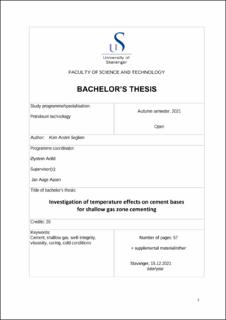| dc.description.abstract | Shallow gas can create challenges for well integrity, local and global environment. During drilling and completion of wells, shallow gas can create dangerous situations resulting to human, environmental and economic consequences. Emission and contributors to global warming is a hot topic in the media these days, and the oil industry is caught up in it. Due to the Paris agreement, Norway is obliged to reduce its emission of climate gas.
Gas leaks from abandoned wells shallow sections is seen as a contributor to climate gas emissions from Norway. The leaking methane provides for a substantial portion of the total emission from the oil and gas industry on the NCS. What causes these leaks and how can it be avoided for future wells?
Leaking wells can be caused by insufficient zonal isolation by the cement. This is mostly caused by gas invasion during the cement settling at low temperature. In this thesis I will be looking into what effect cold temperature conditions has on neat class G and class A cement rheological and strength properties. Can class A cement be of better use than class G in shallow sections? | |
